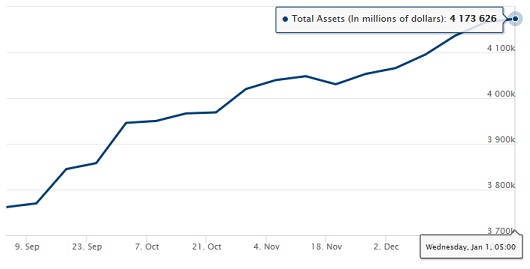Courtesy of Pam Martens
By Pam Martens and Russ Martens
On September 4, 2019, the assets on the balance sheet of the Federal Reserve stood at $3.761 trillion. As of January 1, that figure is $4,173,626,000,000. That’s an increase of $413 billion in just the past 119 days and the Fed does not seem inclined to turn off its money spigot to Wall Street anytime soon. At the rate the Fed is now going, its balance sheet is likely to eclipse the $4.5 trillion all-time high it reached in 2015 as a result of the unprecedented sums it funneled to Wall Street following the epic financial crash in 2008 and its three rounds of quantitative easing (QE) to keep interest rates low to appease Wall Street’s trading houses and their trillions of dollars in interest-rate derivative bets.
When Jamie Dimon, Chairman and CEO of JPMorgan Chase, testified to the Senate Banking Committee on June 13, 2012 about billions of dollars in derivative losses at his federally-insured bank, he had this to say about the major dangers facing his bank – the largest bank in the U.S. “There are two major risks that J.P. Morgan faced: dramatically rising interest rates and a global type of credit crisis. Those are the two biggest risks we face,” Dimon stated.
The Fed, through its open money spigot and trading arm – the New York Fed – has been a Fairy Godmother to Jamie Dimon. It has kept short-term interest rates at historic lows since 2008 and postponed the inevitable global financial crisis long enough to allow Jamie Dimon and his pals on Wall Street to become billionaires. The flipside of Jamie Dimon’s wish list has been to impoverish millions of retirees who have seen their interest income on Treasury notes and Certificates of Deposits cut in half for more than a decade and to fuel an unprecedented corporate debt bubble in the U.S. as a result of that cheap money.
Now, instead of the Fed winding down its latest money spigot that it opened on behalf of Wall Street’s trading houses on September 17, it appears to be gaining momentum. Yesterday, the $35 billion that the New York Fed provided to Wall Street in 14-day term loans was oversubscribed by $6.12 billion. On top of that, the New York Fed also pumped out $63.919 billion in overnight loans for a total of $98.919 billion – in just one day.
…




